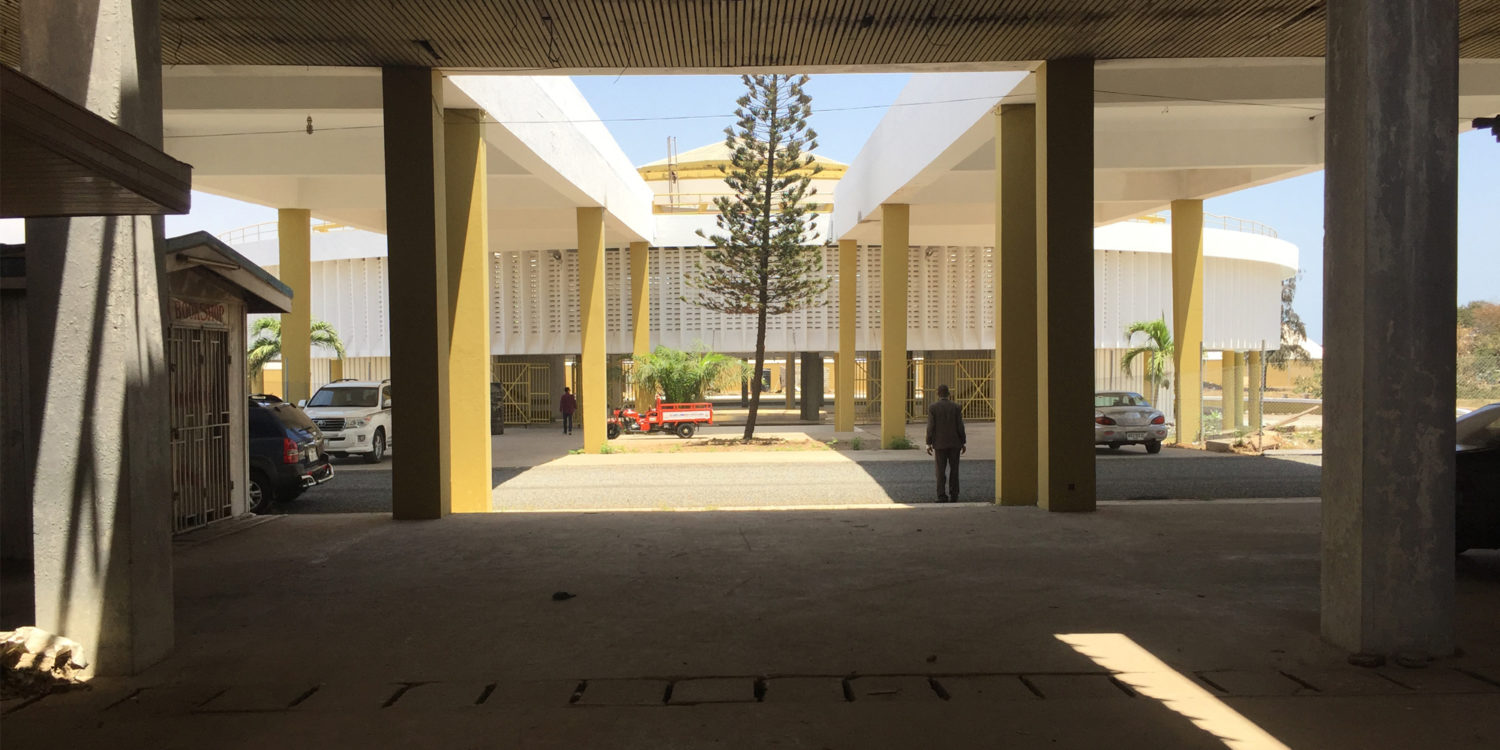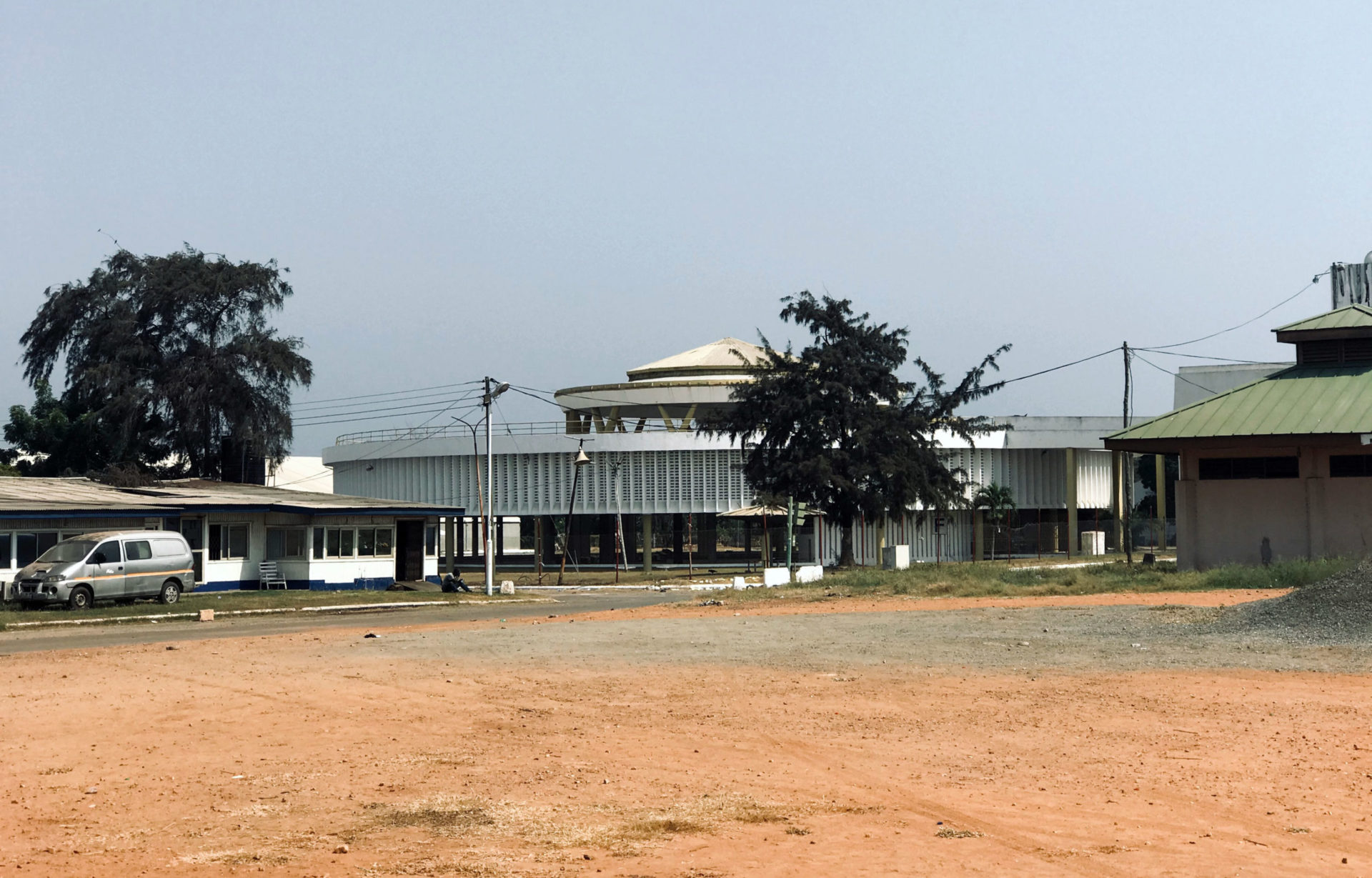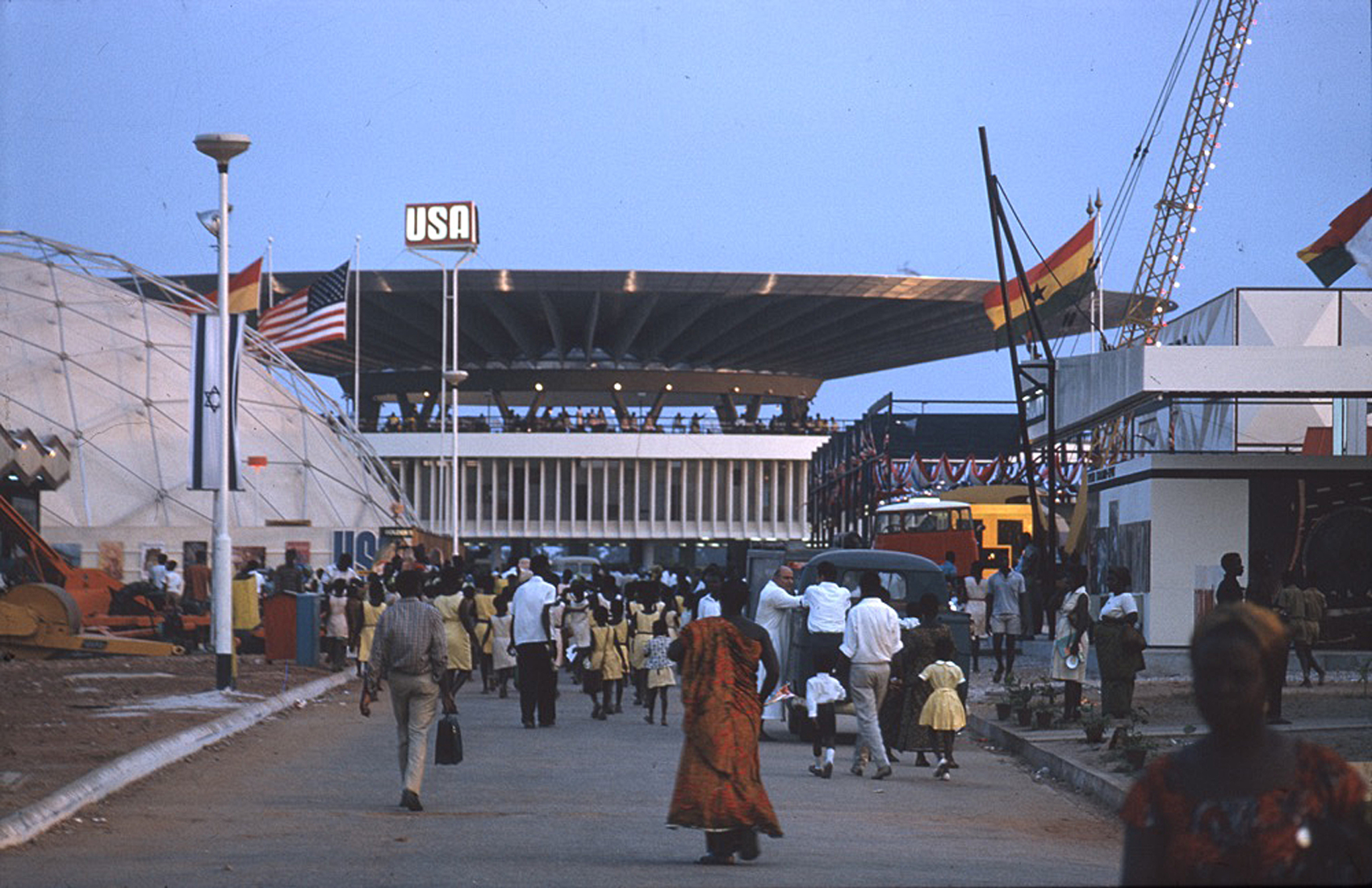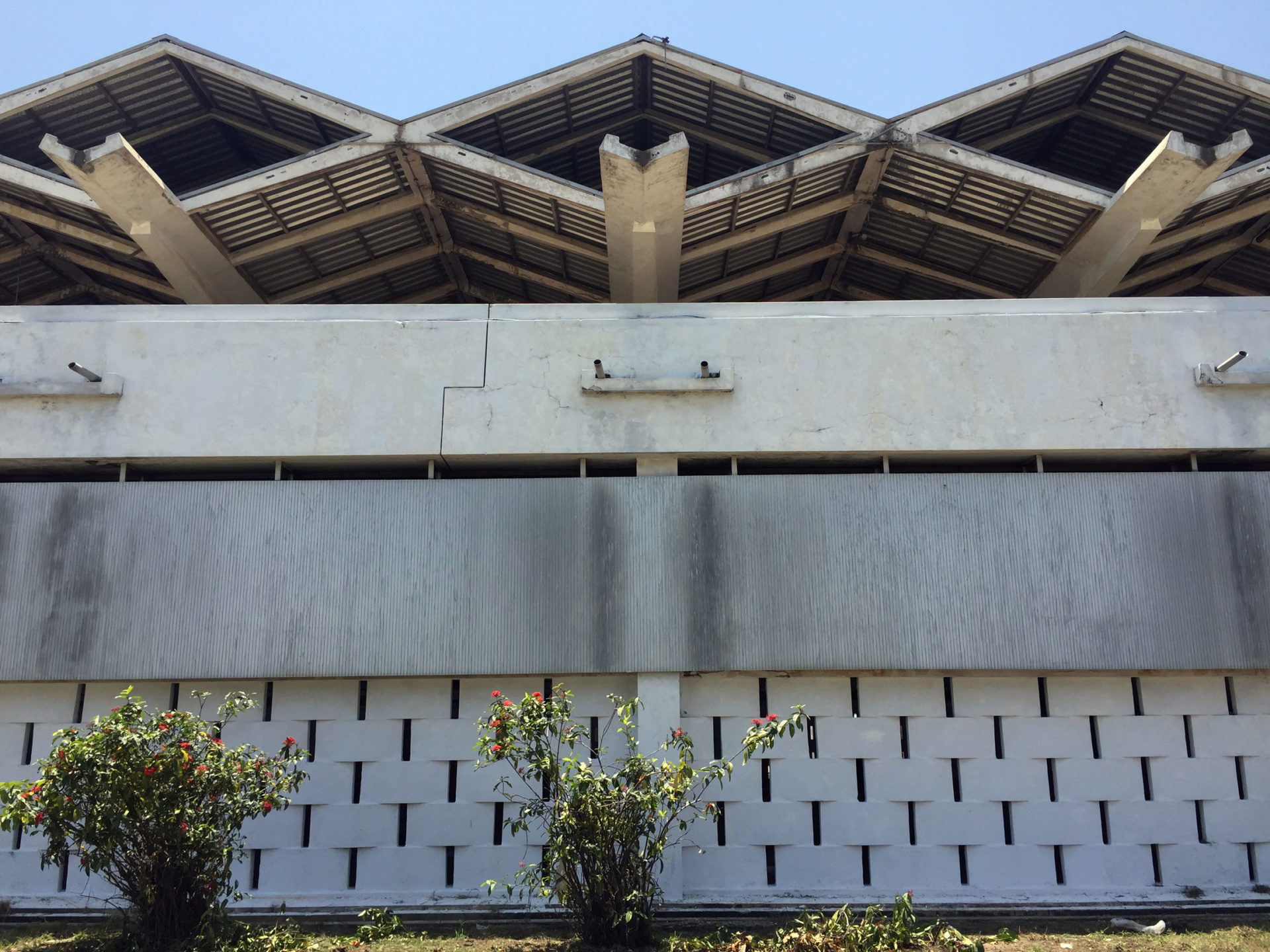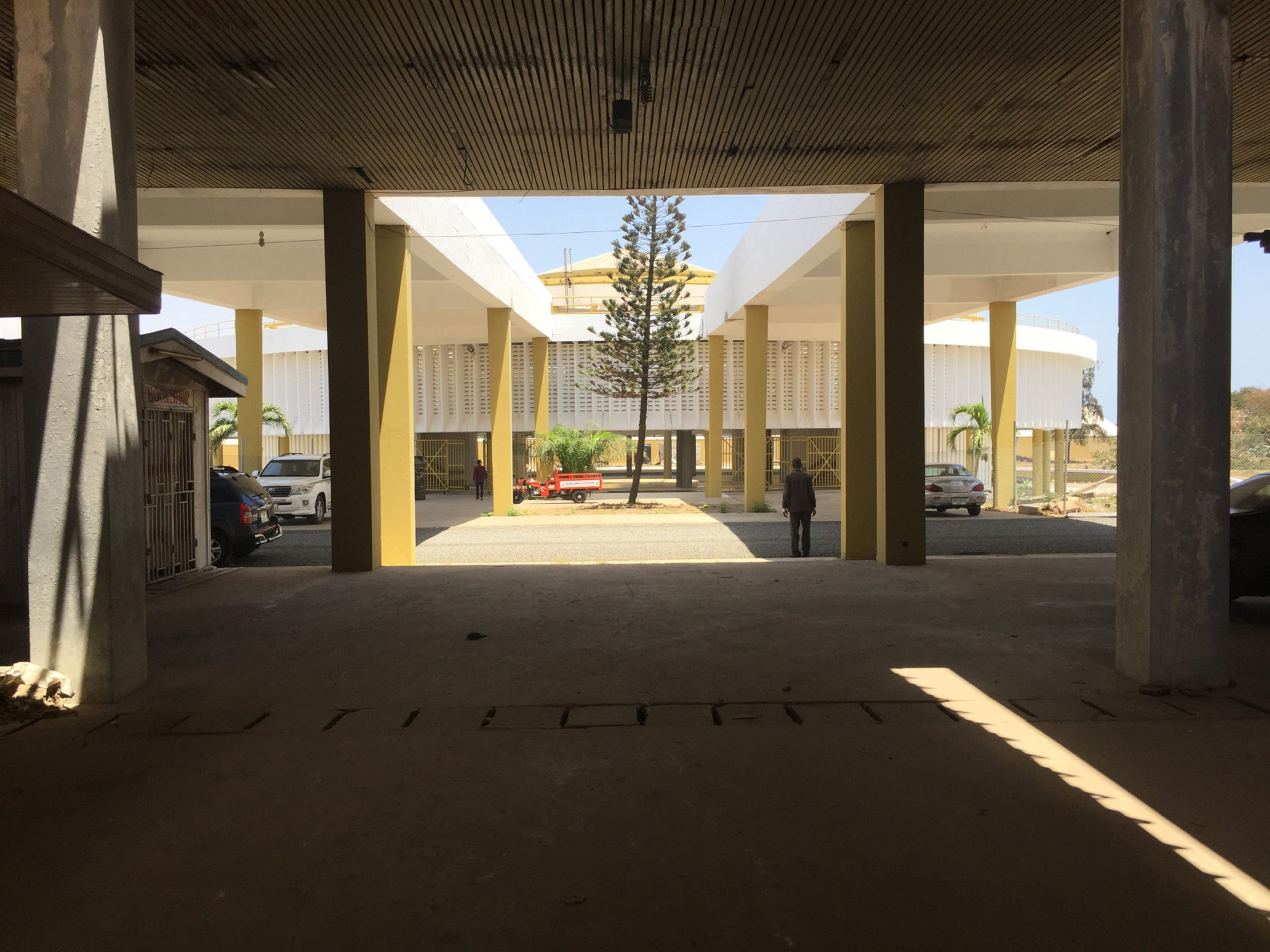The International Trade Fair in Accra, Ghana, was a hugely ambitious project launched during the first decade of Ghana’s independence. Designed and constructed in the course of the 1960s under the government of Kwame Nkrumah, it emerged within a framework of socialist assistance that brought together Ghanaian architect Vic Adegbite and Polish co-designers, Jacek Chyrosz and Stanisław Rymaszewski. In this context, the Fair’s grounds were envisaged as a hub of Pan-Africanism, a representation of the new nation-state, and a stimulus for the urbanisation of the city of Accra according to ideas of socialist development and against the perceived neocolonialist blueprint conceived by the country’s former coloniser Britain.
Yet this modernist venue was opened only after Nkrumah was toppled in 1966, and since then the development of the Trade Fair and the area around has been characterised by constant adjustment, appropriation, and modification in response to the rapidly changing political and urban reality. Currently being re-planned by the office of Adjaye Associates, this ensemble encapsulates the various conflicting forces affecting urbanisation in Accra today: rapid urban development, new types of private-public partnership, intense real estate speculation, displacement of vulnerable inhabitants, urban activism, and the still-contentious legacy of the Nkrumah period.
This conversation between Accra-based architect and editor of The Architect’s Newsletter, Ruth-Anne Richardson, and Łukasz Stanek, an architectural historian at the University of Manchester and author of Architecture in Global Socialism: Eastern Europe, West Africa, and the Middle East in the Cold War, attempts to unpick the complex web of current and historic meanings ascribed to the International Trade Fair. In the course of the conversation, the site emerges as a window into the fitful progress towards Nkrumah’s vision of regional economic, political and cultural integration. Its persistent centrality to Accra’s urban realm, however, attests to the continued relevance of this original vision: to Accra, Ghana, and Africa at large
Łukasz Stanek: Ruth, could you explain the location of the Trade Fair in Accra today and its role in the city?
Ruth-Anne Richardson: The Trade Fair as envisioned during the government of Dr Kwame Nkrumah was intended as an urban connector, a node for multi-layered exchange. Its siting was strategic in that regard. Interestingly, when you study the master plans of Accra during the 1960s, there was very little linkage between the townships of La, Teshie, Nungua, even Osu and more so, very little infrastructural development within the township. It was perceived as nearly impossible to see oneself from ‘here to there’. The siting of a development of that magnitude, on 127 acres of land within the La township and on the eastern outskirts of central Accra no less, changed all that. It involved the creation of new roads that facilitated the linkages between these townships, it recentralised the heart of the metropolis and established an important alignment with Accra’s vital urban edge, the Gulf of Guinea waterfront. The present Giffard Road developed during the Acheampong era in the 1970s, with its streetlight procession leading to the ITF, as well as the Ring Road were all-important connectors to the Trade Fair site and are still major roads today.
The strategic positioning of the ITF indicated the strength of urban planning processes at the time, as well as the positive impact of international partnerships on national development. Case in point, your book reveals the collaboration between Ghanaian planner Peter Turkson and the Polish urban planners, Grażyna Luba and Jerzy Luba, who worked together at the Town and Country Planning Division in Accra. Their master plan for the Labadi township used the design of the Trade Fair in order to modernize and improve the township. Just as with the architecture of the Trade Fair, co-designed by Ghanaians and Poles, these instances of international collaboration show how Dr Nkrumah harnessed creative synergies as part of Ghana’s nation-building process.
ŁS: What are your personal associations with this area?
R-AR: The ITF is a place that still gives me a sense of wonder even in its considerably underoccupied state. It is an experimental world. There were very few prominent architectural landmarks in Accra at the time of the Fair’s construction and this complex stood out clearly.
As a landmark, the ITF is integral to Ghana’s history of both political and architectural independence, and it contributed to the advancement of tropical modernism in Ghana. The showcase African Pavilion for example, with its iconic disc roof — best described as an inverted shallow dome — is a strong visual connector on approach. The roof gave way to collapse over 10 years ago sadly, owing to the lack of maintenance.
Those are my first recollections about the ITF, but I was born long after its first opening. I do also share indirect history with the Trade Fair as it was opened by my uncle Lt. Gen. Joseph Arthur Ankrah, at that time the president of Ghana. Unlike Nkrumah’s close alliance with the Soviet Union, Ankrah sought a shift in perspective and the opening of the ITF in 1967 was key in symbolizing this shift. East and West blocs were represented as well as neighbouring African countries and representatives of the Commonwealth.
More recently, a friend shared his earliest visual memories of the Trade Fair in the late 1960s. He described his sense of awe as an eight-year-old boy upon entry into the fairgrounds, his fascination with lights, the scale of the pavilions, materiality and the various activities held within the different pavilions. He spoke of his barely contained excitement at seeing the advertised ‘rotating roof of the African pavilion’ and of course his disappointment that it did not indeed rotate. He recalled hopping on one of the Big SIX buses to the fairgrounds with friends and stopping for ice cream. He saw the equipment exhibits such as sugarcane juicers, orange peepers, crank machines for garden eggs which you wouldn’t see commercially anywhere else, forestry equipment being exhibited at Polish stands. He watched and listened to bands that played, danced a little and then pulled away to immerse himself in the technology area, or listen to a speech or visit the Chinese stand — where he claimed he had never seen so much colour as with all their exhibits— or visit the Italian pavilion to see their model of the Akosombo town. The Trade Fair as it was then showed him a breadth of possibilities and nurtured his early desire for travel and exploration.
I compare these memories of my friend, with the site that I know and attempt to look at it through his eyes. These are memories of spatial linkages, access and circulation flow, public connection, enclosure… all very tangible experiences that tell us how much design of a space can create a sense of place, embodied with concrete memories – so architecturally for me, the ITF was a triumph.
R-AR: But tell me about your thoughts of the Fair, Łukasz, how do you see it as an architectural historian?
ŁS: To my mind, this project, and others by the Ghana National Construction Corporation (GNCC), testifies to the cosmopolitanism of Ghanaian architecture under Nkrumah. At that time, Ghana’s traditional links to Britain, and to other British colonies, were extended and opened up towards new locations, including the Non-Aligned Movement, other African countries, and Eastern Europe. I argue in my book that sites such as the ITF make it clear that the process of architecture becoming global after World War II was not reducible to the continuities of colonial links nor to Western-based “globalization”. It testifies to the roles of other world-wide projects of collaboration and solidarity, such as the Non-Aligned Movement and socialist internationalism. It was through the negotiation of the risks and the emancipatory potential of this opening that Ghana’s nation-building process unfolded. In that sense, it was an experience of navigating in a multilateral world.
The ITF also shows how the deployment of modernist, abstract forms was a strategy for creating shared symbols and shared spaces for a multi-ethnic society. As you know, a potentially explosive inheritance of the colonial rule were tensions between ethnic groups in Ghana, and Nkrumah considered “tribalism” to be the greatest danger to the newly independent country. This is why the designers, as they told me, needed to convey a sense of national identity but without references to specific ethnic cultures. Unlike, for example, British ‘tropical architects’ Fry and Drew who used Ashanti ornaments in their school in Kumasi. This is why Adegbite and other GNCC architects tried to come up with forms that were both evocative to West African cultures and yet abstract enough not to be connoted with specific ethnic traditions. The round Africa Pavilion is an example, which was supposed to refer to an umbrella, the West African symbol of power and prestige.
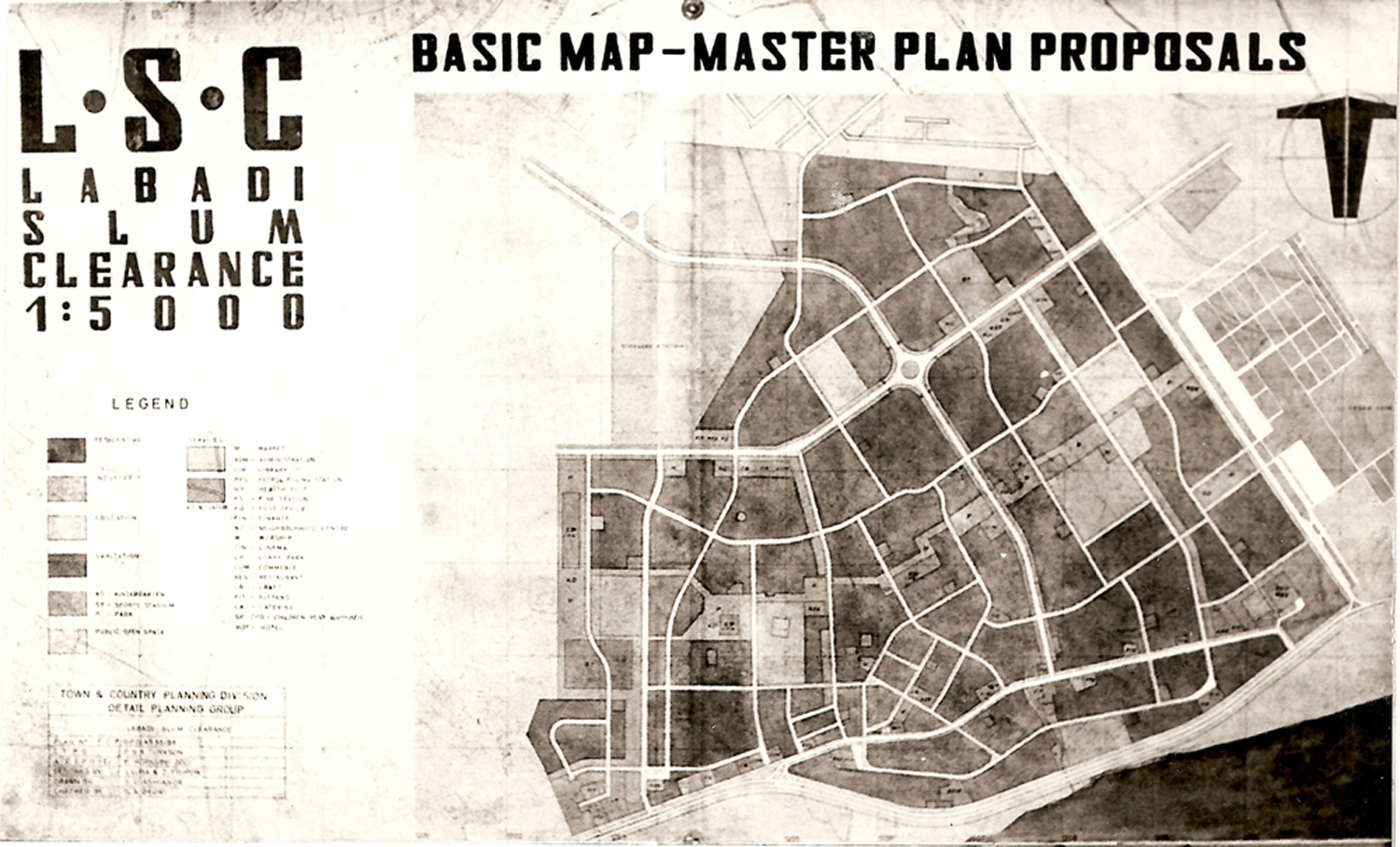
“Labadi Slum Clearance. Basic Map—Master Plan Proposals,” mid-1960s.
Town and Country Planning Division, Peter Turkson (chief planner), Grażyna Jonkajtys-Luba, Jerzy Luba. Private archive, Warsaw (Poland). First published in Ł. Stanek, Architecture in Global Socialism. Eastern Europe, West Africa, and the Middle East in the Cold War (Princeton NJ: Princeton University Press, 2020).
ŁS: What is your sense of the ways in which Nkrumah-era architecture is perceived today in Ghana?
R-AR: Curiously, there is a lot of struggle over acknowledging Nkrumah’s legacy. It is undeniable that he was a visionary who established the foundation for most of the economic and infrastructural developments we have.
The experimental nature of architecture at that time aimed at an identity for modern Ghana, beyond the legacy of the British Gold Coast. Built form, as you said, was expressive but not ethnically symbolic, and it responded to the tropical, hot and humid climate. The choice of construction materials and technologies began to account for the emerging local material-production industries.
The problem I see was the effect of political disruption to a very young independent state – the slow, and in cases halted pace of socio-economic development, which inevitably meant a lack of advancement for Ghanaian architecture. The body presently responsible for this advancement, the Ghana Institute of Architects (GIA) established in 1962 under Nkrumah, faced a period of dormancy but has recently reassumed its role of promoting and advocating Ghanaian architectural heritage and identity. Similarly, the School of Architecture at the Kwame Nkrumah University of Science and Technology (KNUST) in Kumasi also went dormant. So, in a sense it was less about Ghanaians consciously looking away from Nkrumah’s nationalist approach to economic development and architecture, and more the combined result of disparate, shifting directions in leadership and socio-economic organisation.
ŁS: To my mind, this discussion points at the key role of architectural educators. Is the Nkrumah period part of the architectural curriculum in Ghana?
R-AR: The short answer is: no. Archival documentation is often very poor here, but we are making progressive efforts both at digitization and digitalization. One of our current studies as a firm is focused on the KNUST, to document its unique architectural prototyping which Nkrumah championed. The campus in itself is another brilliant example of tropical modernism to many architects and urbanists.
This discussion for me brings to light the bigger issue of the teaching of architectural history, including the history of cultures, which continuously excludes the in-depth appreciation of the history of regional and tropical modernism. What is rarely considered is how by studying these histories and tracking their progression, the state of tropical African modern architecture becomes much clearer and allows us to respect both aspects of geography and site.
ŁS: Let me come back to the ITF which, with the new master plan, has become a crucial site for the negotiation between modern heritage and development in Accra. What are the current attempts to develop the area?
R-AR: In recent times, the Trade Fair has been under-utilised and insular. A drawn-out period of political instability with several regime changes affected the running and maintenance of the fairgrounds significantly. Ghana Trade Fair Authority gave way to Ghana Trade Fair Company Limited in 1997. The privatization of the facility resulted from the efforts of the government at the time to decelerate the loss in revenue, as similarly done with other state institutions.
During the last quarter of 2019, a proposed master redevelopment by Adjaye Associates was accepted and approved by the Ghana Trade Fair Company Limited (GTFCL) for implementation after numerous other design submissions. A lot of the Fair’s tenants, including local businesses and light industries, were opposed to this move to restructure the site. GTFCL, however, claimed due diligence with necessary stakeholder engagements and repeated notices for tenancy agreement renewals. Let me say that, while it is entirely right for the ITF to undergo a reconstruction aimed at making necessary improvements, I would question GTFCL’s level of engagement with relevant entities such as the Ghana Institute of Architects, the Ghana Museums and Monuments Board and other state and non-governmental bodies in determining the value of this site in terms of architectural heritage. When we introduce this subject of architectural heritage, we introduce an aspect of the enormous multi-contextual relevance of the ITF, clear criteria for any architectural heritage site by ICOMOS standards. This type of all-inclusive stakeholder engagement within an urban regenerative process, however protracted, would secure necessary protection and preservation of memory for an urban generation who currently have little or none. I am very interested in understanding how the master plan by Adjaye Associates will redefine and incorporate the various elements of the site. My obvious hope, beyond a comprehensive documentation of the site and its architecture, would be for the project to include existing buildings of significant architectural, historic value and varied scale, with programming that builds on pre-existing spatial connections and linkages.
ŁS: The inclusion of the neighbouring areas into the ITF project during the 1960s was part of the Nkrumah-era socialist vision of a broad distribution of housing, schooling, education, and culture. Is it possible to think in these terms today, given the rapid urban development in Accra, combined with an aggressive real estate market, and often resulting in the displacement of vulnerable inhabitants?
R-AR: As we have already discussed, political instability took its toll on the developmental agenda for the country, impacting the prospects of an equitable provision of housing. A huge part of the problem, for instance, is how the real estate markets do not provide opportunities for homeownership to urban dwellers in lower-income brackets.
However, we need to understand that the state is still a key player in the real estate industry. Several housing schemes have been embarked upon by current and previous governments. It is possible to conceive the idea of equitable development, however, it must be preceded by revisions to our master plans indicating redefined land use and new zoning intentions. Currently, the Land Use and Spatial Planning Authority (LUSPA) is mandated to oversee the development and production of master plans for Ghanaian cities. Their progress to date is of keen interest to me.
Where the ITF is concerned, another challenge is the struggle around the ownership of the fairgrounds. It resulted from the expiration of the government’s lease on the lands and what the chieftaincy sees as a change in the use of the lands, which requires a sanction from the Traditional Council. In Ghana, there are state lands and there are customary lands of which the chieftaincies are in charge. This is where the problem begins: conflicts in the administration of land rights and varying conditions for title security. The underlying mindset and present strategies towards urban space and city development need to change urgently.
However vast the issues, my thoughts are that the ITF site undoubtedly still plays a crucial role in urban development for Ghana. As was intended from its inception, the site remains an urban catalyst, clearly helping support the argument that the public spaces of today cannot be realized as sole entities but as interwoven parts of a whole system. Even this demonstration in itself is a triumph for the ITF given the repeated cycle of interrupted built narratives it has survived. After the decision to locate in Accra the Secretariat for the African Continental Free Trade Area, a market of 1.2 billion people, the International Trade Fair will be central to encourage intra-African trade within Ghana and strengthen regional integration. It’s a prospect that potentially brings full circle the ambition birthed by Dr Nkrumah over half a century ago.
